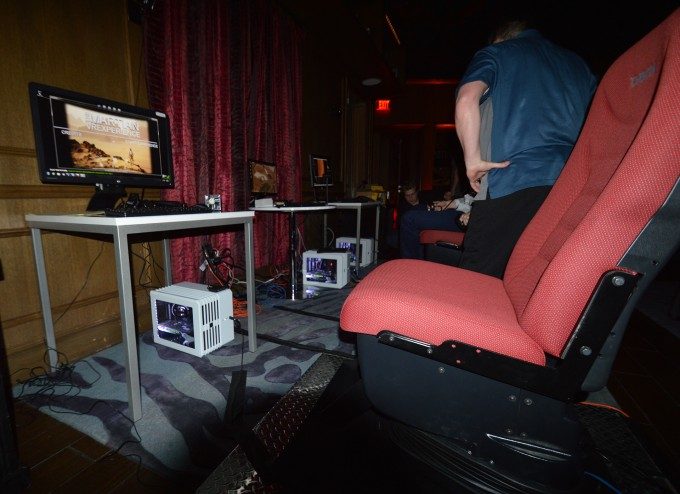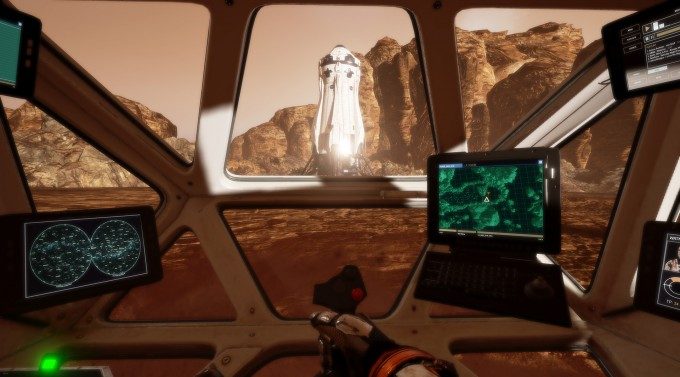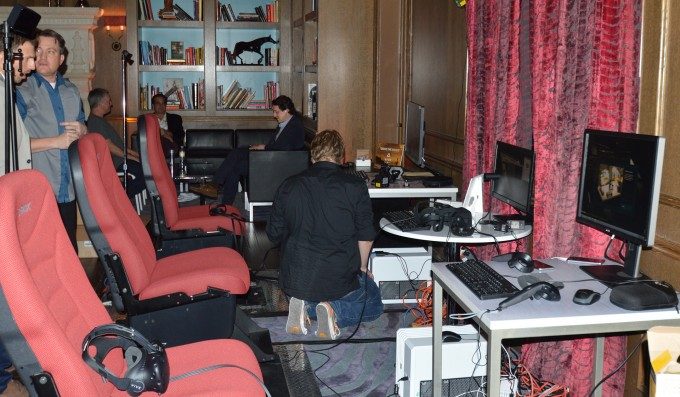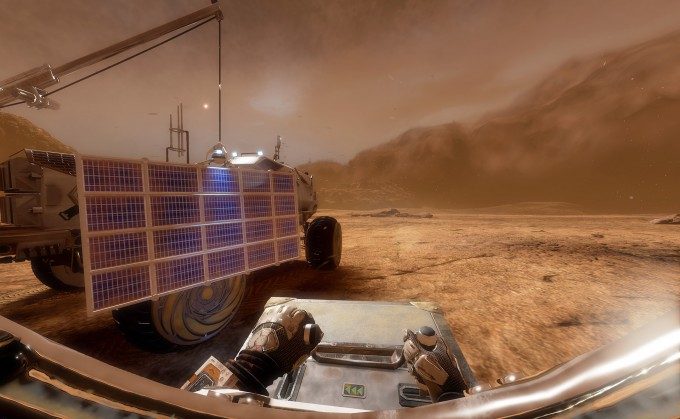We went hands on with the new, real-time, VR experience inspired by the Ridley Scott movie ‘The Martian’ and found its mix of high production values, motion controllers combined with motion chairs seriously compelling.
Ridley Scott’s The Martian is a delightful movie, celebrating as it does the enduring human spirit in the face of adversity and, above all, Matt Damon’s ability to talk to himself. It’s set on Mars and centres around Mark Watney’s (Damon) struggle to survive on that planets harsh, unforgiving surface after he is left behind, presumed dead, by his expedition crew mates fleeing a Martian storm.
The studio behind the movie, 20th Century Fox, has seemingly picked The Martian as a project on which to really begin stretching its legs creatively too, with the final version running some 20-30 minutes long, and all in real-time rendered virtual reality. And whilst the phrase ‘tie in’ (and The Martian is most certainly one) may well illicit a groan from those older readers who’ve endured countless disastrous and sloppy examples of the form over the years, VR seems to be rejuvenating the form significantly. As a new entertainment platform with endless possibilities, VR presents an excellent stage upon which to make the movie tie-in feel exciting again. The Martian VR experience comes from Executive Producer Ridley Scott and Director Robert Stromberg, an Academy Award winning SFX veteran whose experience includes Avatar and Maleficent and who recently became the founder and CCO of The Virtual Reality Company.
Firstly, a confession. I was kindly asked by the folks at Fox and their Innovation Lab division to come along to try the full blown 20-30 min experience, debuting for the first time at CES 2016. However, due to a misunderstanding and some bad luck, I managed only to try the shorter Mars Rover based experiences whilst there. That said, I really wanted to share what I saw and felt in those short demo’s – especially as I was able to try the experience on both the Oculus Rift CV1 the HTV Vive Pre and both platform’s motion controllers.
 Fox’s Innovation Lab, a division set up to experiment with new technologies to see how the studio might use them to expand their scope in the entertainment space, was tasked with creating a compelling immersive experience based on the film. Virtual reality it seems is really firing the imagination of Fox Studio execs, no doubt thanks to the infectious enthusiasm (and I suspect tenacity) of Futurist Ted Schilowitz, whose passion for the tech really shone through at last year’s VR Advisory Council held during E3. Fox’s President of Home Entertainment Mike Dunn has also played a significant part in driving the company’s VR strategy along with Ted Gagliano, President, Post Production. EVP of Production David Greenbaum at Fox Searchlight Pictures too has “caught the VR bug” and now oversees Fox Innovation Lab’s creative direction in VR. Encouraging indeed that senior execs at Fox are onboard with virtual reality at such an early stage.
Fox’s Innovation Lab, a division set up to experiment with new technologies to see how the studio might use them to expand their scope in the entertainment space, was tasked with creating a compelling immersive experience based on the film. Virtual reality it seems is really firing the imagination of Fox Studio execs, no doubt thanks to the infectious enthusiasm (and I suspect tenacity) of Futurist Ted Schilowitz, whose passion for the tech really shone through at last year’s VR Advisory Council held during E3. Fox’s President of Home Entertainment Mike Dunn has also played a significant part in driving the company’s VR strategy along with Ted Gagliano, President, Post Production. EVP of Production David Greenbaum at Fox Searchlight Pictures too has “caught the VR bug” and now oversees Fox Innovation Lab’s creative direction in VR. Encouraging indeed that senior execs at Fox are onboard with virtual reality at such an early stage.
The Martian has been developed as a multi-platform VR experience, with desktop VR platforms Oculus Rift and HTC Vive both receiving public releases at some point after the headsets reach market in Q1 and Q2 respectively. Fox Innovation Lab have also embraced each platform’s motion controllers too ( both Oculus Touch and SteamVR), keen to encourage users to reach into the virtual worlds they’re creating. Also, for this special CES event, motion simulator chairs provided by veterans of the field D-Box, were incorporated into the experience.
The experience starts with a short calibration sequence. On both Oculus and Vive platforms, you’re asked to line up your held controllers with green positional markers in 3D space – once you’ve done this, you’re effectively sitting with both arms outstretched to the side – once this is done, you stare ahead to calibrate your view and you’re done.
After a short excerpt from the movie, which seemed a little unnecessary (the only part of the experience that conjured memories of those bad old days of the tie-in) you find yourself in an airlock. Reaching out with your motion controller, holding the trigger on either allows you to wrench down with one naturalistic motion and presto!
You’re then transitioned to the driving seat of the rover vehicle, so prominent in the movie, and this is where the fun really begins. Just sitting there, glancing around the environment and cockpit, the production values Fox Innovation Labs have lavished here are immediately obvious. The cockpit is lovingly rendered, with the development team clearly having fun working on those little details that can be so wonderfully appreciated in virtual reality.
As you look down, you see your spacesuit clad arms and hands are rendered to mimic your movements with the motion controllers. Holding the trigger on your controller activates a contextual action. What’s immediately rewarding, and indicative of the development team’s attention to detail, is that reaching out with my left hand, I’m able to use that contextual action to flip various switches on the dashboard. These moments may seem trivial, but they can be so very important to sell presence in a virtual space, it’s always rewarding to find experimentation like this paying off.
Once I’ve finished exploring my new reality, I reach out with my right hand and grab the rover’s control stick, push forward and immediately I’m taken aback (literally as it happens) as my chair lurches and bounces me as the rover moves from stop to go – running as it does on suspension with plenty of ‘give’. It’s unlike anything I’ve felt before in VR, and it catches me off guard to such an extent I immediately let go of the virtual stick – bringing the rover to a lurching stop and once again those motion and vibrations from my D-Box powered chair selling the weight and power of the vehicle. With a huge grin in my face, I reach out again – a little more gently this time – and edge the virtual stick forward. As I pick up speed and traverse dips and dumps, that motion feedback once again providing some startlingly effective sensations. I can sense the speed and heft of this mammoth machine and I back off on speed as a result of that force feedback from the environment.
This 5 minute experience is really just a simple A-B drive to checkout your craft a short distance away, but I had endless fun just testing out the limits of the vehicle on the Martian surface, checking to to see what the motion chair could do. There was no real gameplay to speak of, it was more a short simulation experience, but it didn’t matter at all. This is the power of VR. You can place someone inside a lovingly rendered world and just let them lose, as long as you’ve made it intuitive enough to do so. I could have spent an hour just careering around losing myself on another planet. The full experience will allow players to fly onto the surface of Mars, steer at zero gravity through space, drive a rover and experience other key scenes from the film.
I played the experience through on both an Oculus Rift CV1 engineering sample with two prototype Oculus Touch controllers and on the new HTC Vive Pre headset and remodelled Steam VR controllers. It was one of the only opportunities I’m aware of to try both of the latest competitor headsets and their motion controllers side by side with the same application. I’ll be going into more depth on my comparisons in another piece, however I’d like to say that – as an early example of a cross-platform VR title using motion controls – both implementations were intuitive and seemed to work flawlessly. This is heartening news for people worried about input fragmentation in the VR space. As there are enough similarities between Oculus Touch and SteamVR Controllers in terms of functionality, it seems simple at a gameplay level to include both with no real issues at all.
The motion chair system from D-box I have to say was a mini revelation for me. Perhaps I’ve been stung by so much 4D cinema gimmickry in the past, but here, the use of vibration and motion feedback in The Martian was sublime, really selling the illusion of physical presence whilst also providing genuinely useful feedback from the virtual world. We’ll hopefully be delving further into D-Box’s technology’s collaboration this and other experiences soon.
All in all, I can’t wait to get my hands on the full Martian VR experience when it eventually launches later this year in the wake of the Oculus Rift and HTC Vive reaching the consumer market. Fox Innovation Lab have done a superb job in lovingly recreating the movies look and feel in the virtual plane, and have clearly had a lot of fun doing so. Motion control implementation was intuitive and rewarding whilst also adding to immersion and both Oculus Touch and SteamVR controller implementation seemed to work equally well.











